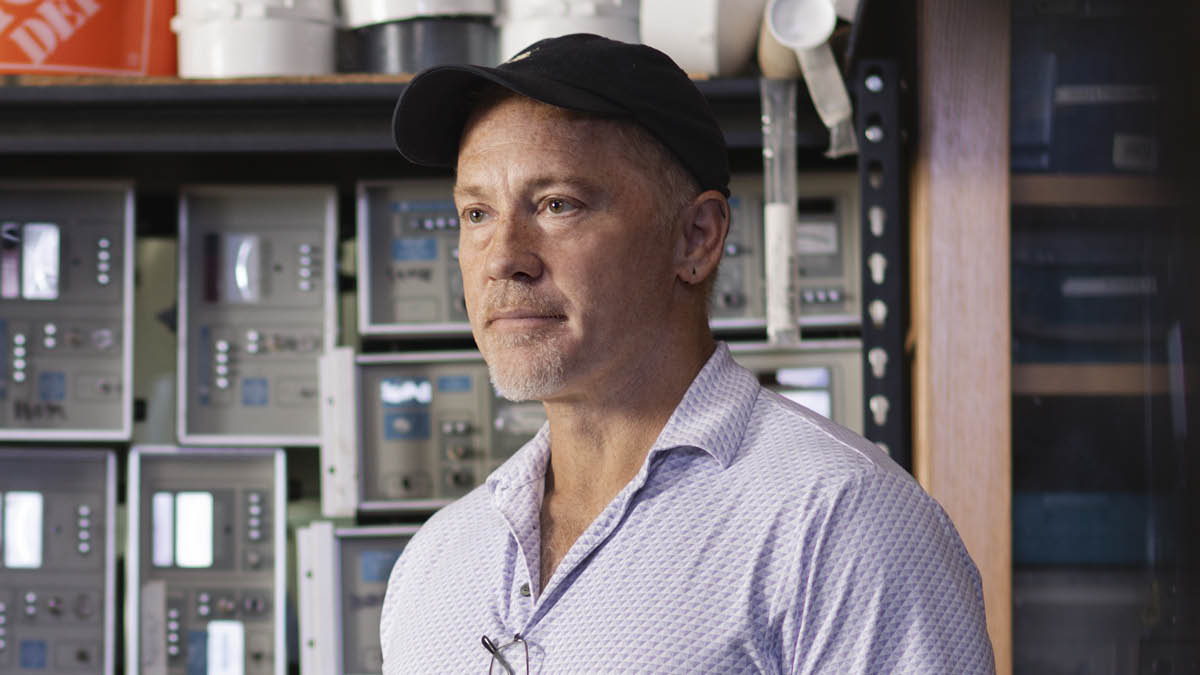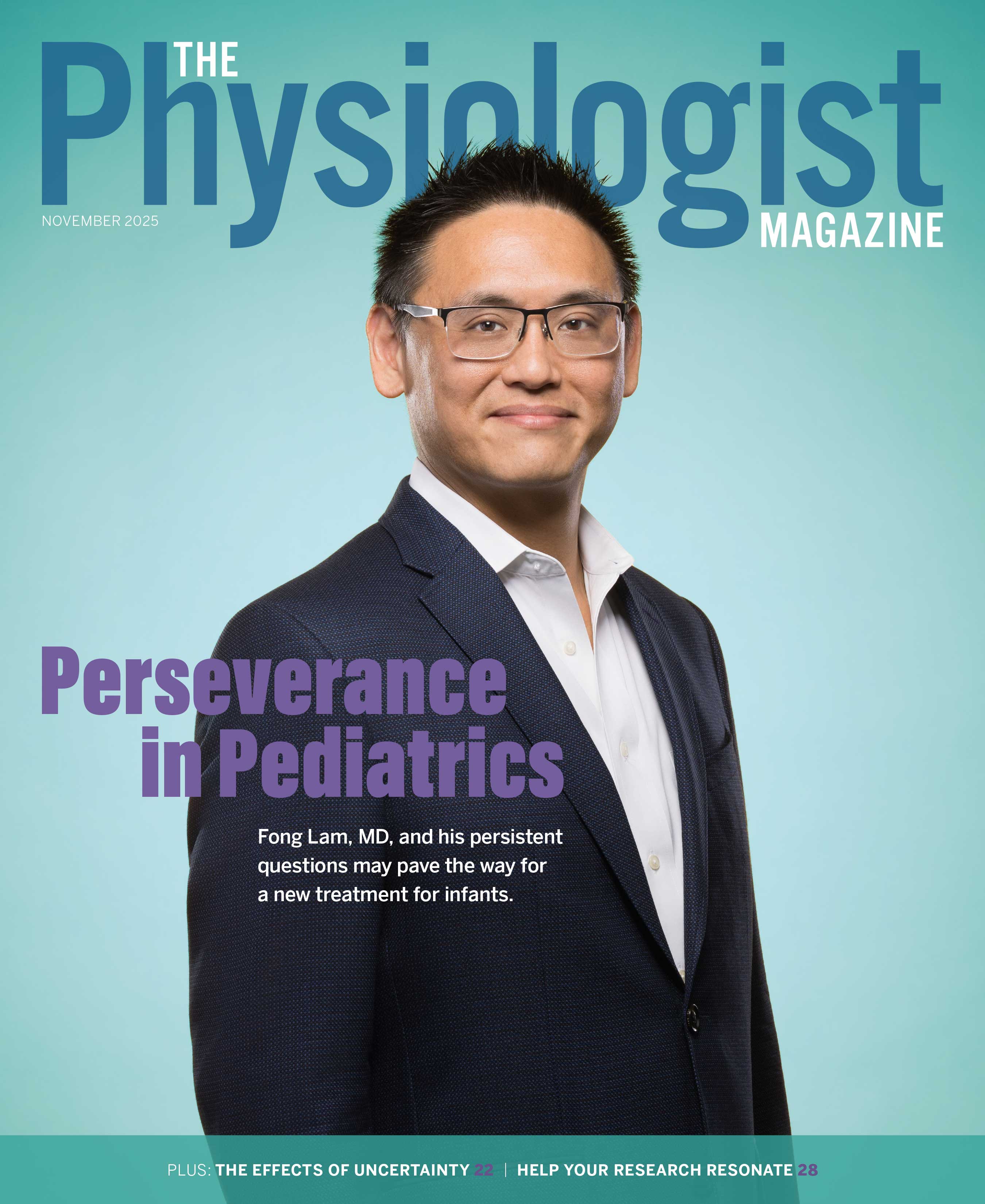Beneath the Scales
Dane Crossley, PhD, studies nontraditional animal models to explore how early-life environments shape physiology—and the implications for human health.
By Sarah Bay

Alligator wrestling is pretty far down the list of job responsibilities for a professor of physiology—well behind teaching, mentoring and research duties—but it still makes the list for Dane Crossley, PhD. When you’re gathering data on alligator exercise performance, you have to be ready for escape attempts, and you have to keep your cool to get the gator back into the pool. Luckily, for anyone interested in reptile cardiovascular function, Crossley is up to the task to make sure the data are collected.
As a kid growing up in the Pacific Northwest, Crossley spent most of his time outdoors. “I was always interested in animals: collecting them, looking at them. Snakes and tadpoles, frogs and salamanders. It’s always been there, as long as I can remember.”
It isn’t hard to connect the boy exploring the creeks of Oregon and chasing down scaly friends to Crossley today, studying developing turtles and alligators. A professor at the University of North Texas (UNT) and chair of the APS Comparative & Evolutionary Physiology Section, Crossley has traveled the world for his research. He studied in Denmark and Sweden and taught in Mexico and Brazil. He conducted field work in Puerto Rico, where he collected frog eggs to better understand heart rate variation between clutches.
Crossley loved biology in high school and went on to double-major in biology and zoology at Oregon State. By the time he graduated from college, he knew he was interested in research and physiology. Out of the countless potential branches of biology, why physiology? “I love puzzles,” he says.
He followed those interests to a master’s degree, working on the regulation of blood pressure in cane toads at Portland State, then headed to UNT for his doctoral research. That’s where his interest in developmental physiology grew. He worked with Warren W. Burggren, PhD, FAPS, diving deep into the development of cardiovascular regulation in the chicken embryo, looking for differences between ex utero development in the egg compared with the better-studied mammalian fetal lamb system. Crossley also studied the same processes in desert tortoise embryos, moving beyond previous descriptive morphological studies and beginning to quantify the physiological mechanisms at play.
As he progressed from graduate student to postdoc, the developmental stage of his research subjects grew alongside him. “I began to understand the embryos, so I wanted to extend that into the juvenile,” he says. At the University of California, Irvine, he assessed physiological differences between clutches of juvenile alligators. Next up, he studied embryonic chicken physiology, first as a postdoc at Oregon Health & Science University and then as a research fellow at Linköping University in Sweden.
Crossley’s wide-ranging curiosity about the “puzzle of organismic function” continued to drive him as he began his independent research career at the University of North Dakota (UND). He continued to work with a breadth of nontraditional models, including avians, reptiles and amphibians.
“By looking at multiple species, you can look at commonalities that are shared, at the common solutions to problems. Then you find, of course, there are also unique features: You have an organism that has a unique way of handling some process, and you can investigate how they deal with that challenge,” he says. “It gives you the capacity to find out which animals are unique in the way they respond to a given scenario, and then to dive deeper into how they do that and whether it is an advantage for them.”
Developing His Lab
Establishing a research lab is no small feat, but for Crossley it was simply the next obvious step in his ongoing journey to try to tease apart the question that, at that point, had fascinated him for more than a decade.
“I was studying developmental programming in bird embryos again, looking at chickens and different species of ducks, and then snapping turtles—all looking at developmental physiology and how the developmental environment influences that developmental physiology. I just kept going, and it’s all evolved from there.”
Crossley was recruited to UNT in 2010, where he remains. Today, his work is a combination of teaching courses, mentoring students and working in his lab—still driven by his fascination with how the environmental circumstances of an animal’s embryonic life can predispose it for different physiologies and alter its physiology as a juvenile and adult. “I’m really amazed by how an event early in development can have long-term repercussions.”
It’s that fascination that led to Crossley working closely with alligators, setting him up for the occasional bout of alligator wresting. Exercising animals raised under different oxygen conditions and comparing blood flows in major arteries has expanded the understanding of those long-term effects. By examining how the creatures of our world function and their adaptations to the challenges imposed by their environment, Crossley, and other comparative physiologists, help us better understand diseases in humans and animals.
Nurturing Future Scientists
Crossley, who has been teaching since his master’s program, thrives on it. At UND, students recognized him as a “faculty star” for undergraduate teaching.
His teaching activities have taken him far and wide, from a course on ecophysiology in aquatic vertebrates in Mexico to courses on cardiovascular and cardiopulmonary physiology in Brazil. At UND, he was a faculty mentor for National Science Foundation-funded summer Research Experiences for Undergraduates. The program was designed to provide hands-on research experience in neuroscience for students from Tribal and rural colleges in the area. He mentored a student completing an honor's thesis at UNT, and his current courses there include comparative physiology and an introductory biology course, which he particularly enjoys because of the excitement students show as they’re exposed to physiology—many for the first time.
When it comes to lab mentorship, Crossley’s approach is tailored to the “developmental stage” of his students—who range from high schoolers to master’s students up through postdocs.
“With the postdocs, I tell them, ‘Here’s the question,’ and give them pretty much free rein—within reason—to do what they think we should do. PhD students are trying to develop their own ideas, and I’m pretty hands-on for the first couple of years for any students who are early on in their degrees, and then later on, I take a step back and let them go.”
Crossley’s science is necessarily collaborative. “I do a lot of surgical interventions and a lot of looking at pharmacological manipulations—low levels of oxygen, high levels of CO2, blood gasses, those kinds of things—but I’m not the expert in, say, transcriptomics. So, I go out and find someone to help with that. I have someone else that helps me with histology and so on.”
This approach underscores Crossley’s desire to understand the full picture, from the smallest pieces of the molecular puzzle to adult physiology.
“I take it from the whole-animal level down to the mitochondrial level so that I have the capacity to study everything from the response of the juvenile down to the mitochondrial responses in cardiac tissue, or at the cellular level, looking at cardiomyocytes and how they function—which again, I do with collaborators. I get their help with doing those kinds of studies.”
Continuing to Build
What excites Crossley most today? “It’s the same thing that excited me when I started: the influence of the developmental environment on the phenotype of the animals. This area of study has been around for a while, but with non-traditional models, we’re still scratching the surface as to how the environment influences their embryos and how that affects the juveniles and the adults.”
He also acknowledges the translational aspect of his work, acutely aware that his research could help mold treatments for human disease. “By studying these nontraditional models, we find out things we would never find out in some other species. Maybe these models can tolerate environmental factors that mammals or humans couldn’t. You delve deeper into the question of ‘How do they do it?’ There clearly are connections between what we find in these nontraditional models and how that might translate to human health.”
Today, when he’s not working, Crossley may be spotted on a fishing trip, communing with some of the aquatic vertebrates he doesn’t study. And while he focuses on mentoring and teaching undergrads and postdocs, he may also be lamenting about how much writing is involved in being a scientist. But he doesn’t mind it too much, just as long as he gets to keep putting the puzzle pieces together.
This article was originally published in the September 2025 issue of The Physiologist Magazine. Copyright © 2025 by the American Physiological Society. Send questions or comments to tphysmag@physiology.org.
The Physiologist Magazine
Read the Latest Issue
Don’t miss out on the latest topics in science and research.
Contact Us
For questions, comments or to share your story ideas, email us or call 301.634.7314.


